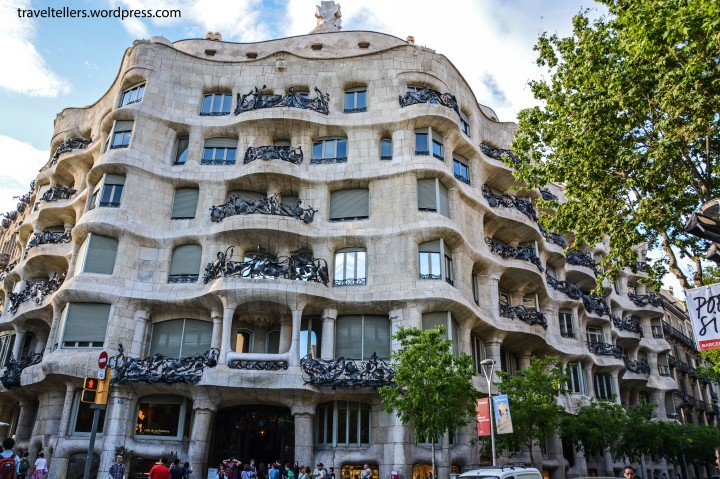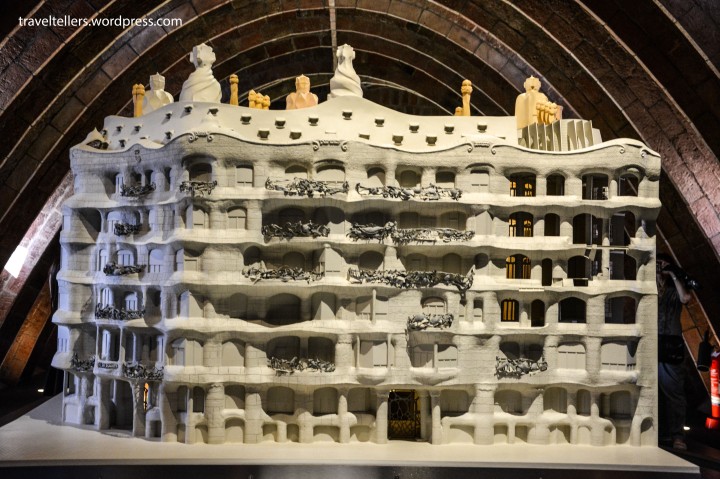Most of the cities, no matter how ancient or how big or how important, keep going through small changes which alter the face of the city little by little. But it is rare for an ancient city to get altered so significantly that it becomes associated with someone or something. Barcelona is a quite an old city, tracing its history back to the Roman era, but in 1852 a man named Antoni Gaudi was born who changed the face of the city forever, thus, giving it a place among the top modern cities of the world.
We had had our fill of ancient Roman monuments and wondrous medieval structures in the cities and towns of Italy and France but now, in Barcelona, it was time to enjoy some of the modern marvels.
A FINAL WORD ON FRANCE
I know we said Au Revoir to France in the last blog but we simply have to recount an incident which happened on the day we left Provence for Barcelona as it resulted in us becoming fans of the French authorities.
We had an 8:40 am train to Barcelona from Avignon TGV station but when we reached the Avignon Central station for our connecting shuttle we found that the scheduled shuttle was not running. We didn’t know whether this was due to that day being a Sunday or some other reason but that certainly put us in a spot of bother. We noticed that there were two elderly couple who seemed to share our predicament. We talked to one of them and found out that they were from New Zealand. They had already informed about their situation to an official who was trying to resolve it. Soon the official returned and informed them that he had arranged a taxi which would take the two couples to Avignon TGV station. The guy from New Zealand told the official that our situation was also the same so he arranged another taxi for us.
Now as far as I see, that official didn’t have to do anything. He could have said that it is a Sunday so the shuttle doesn’t run or there is some glitch so please make your own arrangements but he arranged free transportation for six tourists so they don’t face any inconvenience. That really made a big impression on us.
Well we reached the station, found the New Zealander couple again, chatted with them for a while, sympathized about New Zealand’s loss to Australia in World Cup final, boarded the train and reached Barcelona in 4 hours.
HOLA BARCELONA
The Barcelona Sants station was quite huge and modern but a drawback of that was we couldn’t find the entrance to the connecting metro station. We asked a few people but they were unable to help us either due to language barrier (how can one not understand the word ‘metro’) or simply because they did not know. Finally after 20 minutes of futile struggle we were directed towards the metro station entrance by a South Asian guy. Once we saw the entrance we realized why we weren’t able to find it because it was so well hidden. Anyways, we boarded the metro and a 15 minute journey followed by a five minute walk got us to our hotel – H TOP BCN City.
Our hotel was located in a residential neighbourhood in the centre of the city. It was situated just next to the magnificent Recinte Modernista de Sant Pau and was less than a kilometre away from the iconic Sagrada Familia. In fact we could see these famous monuments everyday as we walked from our hotel to the metro station and back. Our room was quite spacious (probably the biggest of our entire trip) and clean. As we were leaving the hotel for sightseeing, the receptionist stopped us and gave us a map on which he marked all the places worth visiting. We thanked him and left to explore Barcelona. Our first visit was to Casa Milà, a Gaudi marvel which was just a short metro ride away from our hotel.
CASA MILÀ – AN ARCHITECT’S DELIGHT
In 1905, Pere Milà and Roser Segimon, a wealthy Barcelona couple hired Antoni Gaudi to design and build a home for them which should also contain apartments that could be rented out. What followed was probably the most innovative home of modern era. Casa Milà, also known as La Pedrera, was the strangest building we had ever seen. The exterior stone façade was an undulating wave like structure, the kind we had never ever seen. We bought the tickets (€ 20.5 each!!), collected our audioguides and entered the building.

The first part of the building that we saw was its courtyard. The courtyard, which acted as the interior façade of the building, was in complete contrast to the grim and monochromatic exterior. A unique feature of the courtyard was a bridge-staircase (Hogwarts anyone?).


From the courtyard we were directly taken to the roof by an elevator. The roof, on first glance, looked like a set from an alien themed science fiction movie. There were so many bizarre structures spread out everywhere that we actually said what the hell this is!! But once we started observing them closely, with our audioguides explaining us the purpose of these structures, we realized that this was the epitome of innovation and brilliance. Gaudi was the master of combining structural, functional and ornamental aspects of architecture and that was what we were seeing. He hated the metallic extensions of chimneys, vents, skylights and staircase exits as they destroyed the beauty of a roof, thus, he designed them in his own unique way which provided a distinct splendour to Casa Milà’s roof.


From the roof we climbed down to the attic. The attic was made up of hundreds of red brick parabolic arches which provided support to the roof. The attic contained the models of Casa Milà and several other buildings designed by Gaudi. We learnt that Gaudi used to design buildings by creating small scale 3D models rather than by making detailed drawings or plans on paper. The attic also contained few pieces of ergonomic furniture made by Gaudi.



After the attic, we were directed to one of the apartments on the top floor of the building which was kept open for public (the other apartments are still used as residences). The apartment consisting of kitchen, bedrooms, dining room, living room, office space and bathrooms was beautifully decorated and had that distinctive Gaudi touch. Even the handles of the doors were designed for optimum use and comfort which showed the attention the great architect paid to even the smallest of things.


We ultimately returned to the courtyard where we were given another piece of very interesting information that Casa Milà was the first building in Barcelona to have an underground car park. The legend of Gaudi just kept growing in our eyes. There were many other features and innovations on display at Casa Milà but neither can I hope to explain them nor can I expect anybody to understand without seeing the actual structure.
THE OTHER CASAS
Just 500 metres away from Casa Milà was another unconventional residential building designed and built by Gaudi – Casa Batlló. Unlike Casa Milà, which was made from scratch, Casa Batlló was made by remodelling an existing building. It was a predecessor of Casa Milà as Gaudi worked on it from 1904 – 1906. The façade of Casa Batlló was covered with colourful mosaic and had weird skull like balconies though that was the only part of the building we saw as we didn’t enter the casa.

Less than 100 metres ahead was Casa Lleó Morera, a residential building designed by Lluís Domènech, a contemporary and competitor of Gaudi. Though undoubtedly beautiful, this building was much more traditional compared to Casa Milà and Casa Batlló. After admiring the building for some time we took a metro to Plaza de España.

PLAZA DE ESPAÑA
Plaza de España, a square near the Montjuïc Hill in Barcelona, was built for the 1929 International Exhibition along with many other attractions in the area. There was a sculpted fountain in the centre of the square but the sculpture clearly suffered from the lack of maintenance while the water in the fountain looked stale and dirty. At one end of the square was Arenas de Barcelona, a bullring that was built towards the end of 19th century. Currently the arena serves as a shopping mall. There was a lift attached to the exterior of the arena which took us directly to the top of the arena. We got an amazing 360° view of the square and the surrounding areas from the roof. There were also many restaurants on the roof for people who wanted to enjoy an evening with a fantastic view of Plaza de España.


MAGIC FOUNTAIN OF MONTJUÏC
Just opposite the Arena, there was a wide boulevard which led from Plaza de España towards the Montjuïc Hill. At the foot of the hill was located the Palau Nacional (National Palace) and Font Màgica (Magic Fountain). These structures were also built for the 1929 International Exhibition. The Palau Nacional serves as an art museum now.

The entrance of the boulevard was flanked by two towers known as The Venetian Towers because they were modelled on the St. Mark’s Campanile in Venice. There were wide walkways on both sides of the road lined with multiple fountains. We sat on a bench for some time, munching on pizza slices and enjoying the ambience of the place.

We resumed walking and soon reached the Magic Fountain where we witnessed a spectacular musical fountain show. After watching the show for a few minutes we proceeded towards the Palau Nacional. The steps leading up to the palace also had several small fountains and cascades flowing down. We spent almost half an hour sitting on those steps with the beautifully lit palace behind us and the fountain show in front of us. Our first evening in Barcelona was truly magical and memorable.




Incredible all kinds of awesome knowledge.
LikeLike
Thank you so much. Just knowing that someone finds our posts interesting and useful makes our day. 🙂
LikeLike
Wow… these are now on my to do list.. we are currently in Barcelona!! Love it already! 🙂
LikeLiked by 1 person
Barcelona is an amazing city. Hope you had a great time there. 🙂
LikeLike
Awesome, love cinque terre! My latest post is about it, go check it out if you like!
LikeLike
Great article! Barcelona was one of the first places we went to on holiday so it has a special place in our heart. We loved the food there as well! The fountain was unfortunately closed when we visited so lovely to see pictures of it here.
https://2weekendwanderers.com
LikeLike